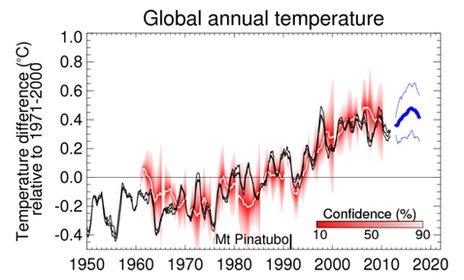Climate model forecast is revised
- Published

The Met Office says its long-term projections forecast significant warming
The UK Met Office has revised one of its forecasts for how much the world may warm in the next few years.
It says the average temperature is likely to be 0.43 C above the long-term average by 2017, as opposed to an earlier forecast suggesting a difference of 0.54C.
The explanation is that a new kind of computer model using different parameters has been used.
The Met Office stresses that the work is experimental.
It says it still stands by its longer-term projections that forecast significant warming over the course of this century.
The forecasts are all based on a comparison with the average global temperature over the period 1971-2000.
The earlier model had projected that the period 2012-16 would be 0.54C above that long-term average - within a range of uncertainty from 0.36-0.72C.
By contrast the new model, known as HadGEM3, gives a rise about one-fifth lower than that of 0.43C - within a range of 0.28-0.59.
This would be only slightly higher that the record year of 1998 - in which the Pacific Ocean's El Nino effect was thought to have added more warming.
If the forecast is accurate, the result would be that the global average temperature would have remained relatively static for about two decades.
Blog suspicions
An apparent standstill in global temperatures is used by critics of efforts to tackle climate change as evidence that the threat has been exaggerated.
Climate scientists at the Met Office and other centres are involved in intense research to try to understand what is happening over the most recent period.
The most obvious explanation is natural variability - the cycles of changes in solar activity and the movements and temperatures of the oceans.

The forecasts are based on a comparison with the average global temperature over the period 1971-2000
A Met Office spokesman said "this definitely doesn't mean any cooling - there's still a long-term trend of warming compared to the 50s, 60s or 70s.
"Our forecast is still for temperatures that will be close to the record levels of the past few years.
"And because the natural variability is based on cycles, those factors are bound to change the other way at some point."
The fact that the revised projection was posted on the Met Office website without any notice on December 24 last year has fuelled suspicions among bloggers.
However the Met Office says the data had been published in a spirit of transparency as soon as it became available from the computer that produced it.
Future forcings
It describes the decadal projections as part of an experimental effort launched in 2004 to fill the gap between daily weather forecasts and century-long estimates for climate change.
But this is an emerging and highly complex area of science because of the interplay of natural factors and manmade greenhouse gases at a time when a key set of temperatures - in the deep ocean - is still relatively unknown.
One aim of attempting to project the climate on this timescale is to be able to rapidly check the accuracy of the models being used.
A paper published last month in the journal Climate Dynamics, authored by scientists from the Met Office and 12 other international research centres, combined different models to produce a forecast for the next decade.
It said: "Decadal climate prediction is immature, and uncertainties in future forcings, model responses to forcings, or initialisation shocks could easily cause large errors in forecasts."
However the paper concluded that, "in the absence of volcanic eruptions, global temperature is predicted to continue to rise, with each year from 2013 onwards having a 50 % chance of exceeding the current observed record".
Scrutiny of Met Office forecasts and climate science generally is set to increase in the build-up to the publication of the next assessment by the UN's Intergovernmental Panel on Climate Change (IPCC) in September.
Update 10 January 2013: The second paragraph of this report has been changed to clarify that the Met Office forecast refers to a long-term average.
- Published6 December 2011